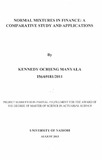| dc.description.abstract | Many studies on modelling return distributions of financial assets have been conducted.
Among them, the most used three-type distributions are the normal, the lognormal and the
non-Gaussian stable distributions. Other types of distributions, such as the Student t, the
skewed Student t, the generalized t, the Generalized Error Distribution (GED), the skewed
GED, and mixture distribution of Gaussian distributions have been examined and proposed.
Out of these, the normal distribution is one of the most commonly observed and applied
distributions. It was widely used in the 1700's and successfully applied to astronomical data
analysis by Karl Gauss in 1800, and became known as the Gaussian distribution. Over time
since late 1960s, the empirical analyses have failed to support the normal assumption on
estimating the return distribution of real financial data.
Distributions that have tails heavier than the normal distribution are common in finance. For
purposes of application such as risk management and derivative pricing it is important to use
relatively simple models that can capture the heavy tails and other relevant features of
financial data. In this project, we study a comparative behaviour of the class of normal
mixture distributions namely: the variance gamma, normal inverse Gaussian, and hyperbolic
distributions that are able to fit the distributions of financial data with ease and, suggest
strategic areas of application in the investment world. The data used in the analysis is the
NYSE Index from 3/0112000 to 1/07/2013.
The study breaks is broken down into six chapters. Chapter one deals with introduction,
problem statement and objectives, and literature review. Chapter two presents the
construction of the variance gamma distribution and its properties. Chapter three presents the
construction of normal inverse Gaussian distribution and its properties and chapter four
presents the construction of hyperbolic distribution. Chapter five discusses the estimation
methodology by the maximum likelihood. Finally chapter six presents estimation results,
interpretation of results and suggested areas of application. | en_US |

